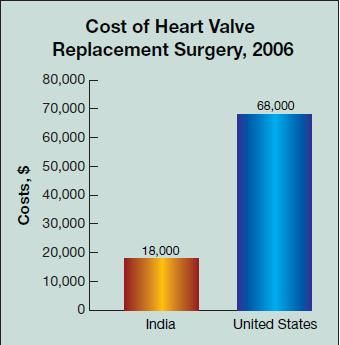US Employers Expand Benefits to Cover Alternative Therapies, Medical Tourism
According to a survey published in January by the International Foundation of Employee Benefit Plans (IFEBP), Brook field, Wis (http://www.ifebp.org), US employers are increasingly covering alternative/complementary therapies and medical tourism as part of their health benefit cost-containment efforts. Currently, chiropractic care is covered by 80.5% of employers, and 33.5% of employers cover acupuncture or acupressure expenses. The IFEBP survey found that medical tourism-a practice in which US residents travel to other nations, such as India, Mexico,and Thailand, to obtain lower-cost treatment (Figure), including heart bypass surgery and hip or knee replacement surgery-is covered by 11% of employers.
According to a survey published in January by the International Foundation of Employee Benefit Plans (IFEBP), Brook field, Wis (http://www.ifebp.org), US employers are increasingly covering alternative/complementary therapies and medical tourism as part of their health benefit cost-containment efforts. Currently, chiropractic care is covered by 80.5% of employers, and 33.5% of employers cover acupuncture or acupressure expenses. The IFEBP survey found that medical tourism-a practice in which US residents travel to other nations, such as India, Mexico,and Thailand, to obtain lower-cost treatment (Figure), including heart bypass surgery and hip or knee replacement surgery-is covered by 11% of employers.

Figure. The cost of heart valve replacement surgery in the United States (with a 3-day hospital stay) is $68,000, compared with $18,000 in India. This figure includes a 10-day hospital stay, 24-hour individualized nursing care, and travel expenses for the patient and a companion. Source: Business Insurance. US Employers Try Overseas Health Care in Bid to Slash Costs; 2006. Available at: www. businessinsurance.com/cgibin/printStory.pl?article_id+19330&a=a&bt=medical+tourism.
The survey, Health Care Benefits: Eligibility Coverage and Exclusions, is based on 400 responses from US corporate benefit managers,professional service providers, public employers, and multiemployer plans about health care benefit plans. According to the survey findings, almost all (99.7%) of respondents offer health care benefits to full-time employees, and almost half (49.9%) cover part-time employees. Nearly all (99%) of responding organizations cover adopted and biological children,74% cover stepchildren, and 42% cover foster children. Most (92%) cover opposite-sex spouses, while 37.5% cover same-sex unmarried domestic partners, 30% cover opposite-sex unmarried domestic partners, and 28.8% cover same-sex spouses.
In addition, approximately 98% of respondents reported that they pay expenses related to emergency department visits for life-threatening conditions, inpatient hospitalizations, inpatient and outpatient surgery and physician visits, imaging and laboratory services, and ICU services.
"Employers need to regularly look at the benefits they offer to make sure they're reasonable yet current and competitive," said Julie Stich, IFEBP senior information/research specialist.
Blue Cross "Lifestyle" Program Lowers Per Member Costs
Blue Cross Blue Shield of North Carolina's (BCBSNC) Healthy Lifestyle Choices program has resulted in an average savings of $187 per member per year. BCBSNC released the findings of a 2-year (2005-2006) study that compared the health care costs o f1171 participants before and after they enrolled in the program. Their combined savings were $437,729, and their health care expenses were one third less than the average trend.
In 2004, BCBSNC found that overweight and obese members cost the company 18% and 32%, respectively, more than normal-weight members in health expenses. To curb this trend, BCBSNC introduced the Healthy Lifestyle Choices program, which offers tools and resources to enable plan members to engage in regular exercise and to improve their nutrition. The program's success has led BCBSNC to expand its healthy living offerings; the program is now part of Member Health Partnerships, which gives members access to a variety of health and disease management resources, including health coaching from a registered nurse and 6 free visits on nutrition.
"This isn't just a quick fix. We know it's the right thing to do, and now economically, it looks like the smart thing to do. We're looking for a true lifestyle change, and that's why we offer people the tools they need over the long term to improve their health," said Don Bradley, MD, BCBSNC chief medical officer.
On January 1, BCBSNC also launched anew program, Medication Dedication, designed to improve medication adherence among plan members with chronic disorders and to make prescription drugs more affordable. BCBSNC began waiving copays for generic drugs used to treat persons with heart failure, hypertension, high cholesterol levels, and diabetes. The company also moved more than 40 brand-name medications used to manage these specific conditions into a lower-cost formulary tier. The program is set to run through 2009.
In 2006, BCBSNC saved members $80 million in out-of-pocket costs when the company waived copays on all generic drug prescriptions. In addition, the number of generic drug prescriptions increased to 58% of the time that year, up from 46.8% in 2004.
We have shown that when patients can afford their medication, they take their medication. Applying a copayment waiver for generic drugs used to treat specific conditions is the next logical evolution in our ongoing efforts to help control health care costs," said Ron Smith,MD, BCBSNC vice president of employer health and pharmacy.







